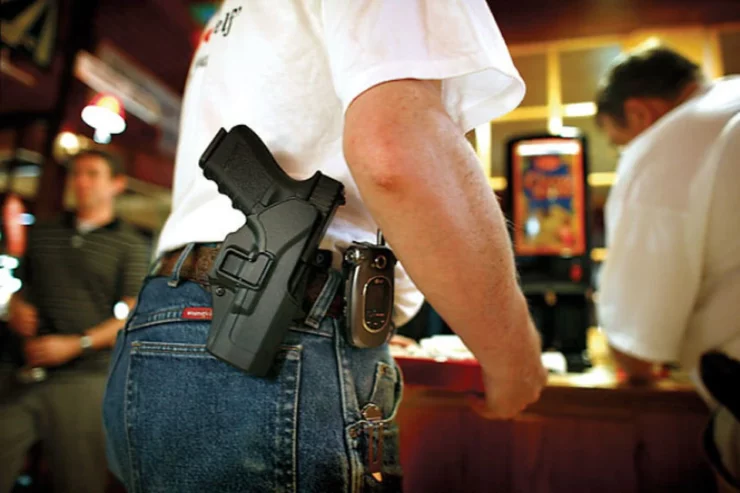
The United States finds itself in the midst of a fervent and contentious gun control debate as more than 600 lives have been tragically lost in mass shootings this year alone. This staggering death toll marks the highest in at least a decade, according to data from the Gun Violence Archive. The urgency of the debate is underscored by the recent and deadliest mass shooting of the year in Lewiston, Maine. While the primary focus of this debate often centers on issues like firearm production, distribution, and consumer access, a less-discussed yet vital aspect is the role of marketing in the firearms’ industry.
The foundation of the gun control debate in the United States rests upon the existing background check system. This system mandates that both prospective gun buyers with clean records and those with a history of criminal convictions or mental health issues undergo an FBI instant background check. The goal is to prevent firearms from falling into the wrong hands. In theory, this process appears robust, but it falls short in practice.
The existing background check system faces significant limitations. One major concern is the absence of critical records in the FBI database. This issue renders the system outdated and ineffective. For example, both the Charleston church shooter and the Texan church assailant managed to pass background checks despite having incriminating records. Numerous studies indicate that universal background checks have limited impact on gun-related deaths due to incomplete and missing records.
Furthermore, the system primarily focuses on assessing “good” and “already bad” individuals, leaving a gray area unaddressed. Individuals without prior criminal records, but who may pose a future threat, often go unnoticed. Thus, a universal background check system would do little to rectify this issue.
An alternative to the flawed background check system is the gun licensing approach. This innovative system, implemented by twelve states and Washington, D.C., offers a more comprehensive solution. Taking Massachusetts as an example, it involves firearm safety courses, thorough background checks that encompass both FBI and local law enforcement databases, and Department of Mental Health scrutiny. The meticulous nature of this process typically takes around three weeks to complete, with an impressive success rate.
The gun licensing system has proven effective in achieving two essential objectives. First, it accurately identifies and screens out unsuitable gun candidates, denying firearms to criminals reliably. Second, it establishes mechanisms to reduce impulsive gun purchases, further enhancing safety.
Studies provide evidence of the positive outcomes associated with gun licensing systems. For example, Connecticut’s implementation of this system led to reduced gun homicides and suicides over ten years. In contrast, Missouri’s abandonment of a licensing system resulted in a substantial rise in homicides and gun suicides in the subsequent decade. The appeal of gun licensing extends to the public, with over two-thirds of gun-owning households and more than three-quarters of all Americans endorsing it.
As the domestic market for firearms in the United States approaches saturation, U.S. gun manufacturers have turned their sights to international markets. However, this endeavor has not been without controversy. Many countries expressing interest in purchasing American firearms often have high crime rates, political instability, or a history of violence, raising concerns about the consequences of exporting U.S. guns.
The U.S. firearm industry’s pursuit of international markets began nearly two decades ago when the 1994 Assault Weapons Ban expired in 2004. This significant event spurred diversification of firearm product lines, particularly focusing on AR-15 style rifles. Manufacturers leveraged financial clout, influence, and advocacy groups like the National Rifle Association (NRA) to expand into new markets and resist gun control efforts in foreign nations.
The regulatory landscape for exporting firearms underwent a pivotal transformation during the Obama administration and culminated in 2020 under the Trump administration. These changes shifted control of firearm exports to the Commerce Department, facilitating the exportation of guns as part of promoting U.S.-made products.
However, this regulatory shift inadvertently classified controversial weapons like AR-15s and .50-caliber guns as commercial items, complicating the global firearms market further. Exported firearms face challenges in terms of tracking their ultimate destination, often ending up in the hands of criminal organizations or on black markets in various countries. The consequences of increased U.S. gun exports are evident in elevated violence levels in many regions.
Marketing plays a crucial yet lesser-discussed role in the firearms’ industry. Unlike products in many other industries, firearms aren’t typically promoted through television commercials, billboards, or online advertisements due to strict policies by major media companies. However, the industry has adapted to promote products through various digital channels, including social media.
A 2022 analysis revealed that major firearm companies exploited loopholes to display millions of ads across Google systems, suggesting that these marketing campaigns are effective. The debate surrounding the marketing of firearms has prompted questions about its role in influencing gun-related deaths and injuries.
The history of firearm influencing and marketing dates back to the late 1800s, with exhibition shooters gaining notoriety through partnerships with firearm manufacturers. While the advertising landscape has changed over time, the role of marketing remains influential.
While there are no federal laws specifically prohibiting gun advertisements in the U.S., gun control activists have taken action at various levels. Some major media conglomerates have banned firearm and ammunition advertising, while restrictions on gun advertisements vary between digital platforms.
The potential exposure of children and minors to gun advertisements has raised concerns. Some have drawn parallels between firearm marketing and tobacco advertising, highlighting the potential impact of these marketing efforts on gun-related incidents.
The pursuit of a comprehensive reassessment of policies is essential to address gun violence and gun control effectively in the United States. By addressing these various facets of the issue, a more comprehensive and coherent approach to gun control can be achieved, ultimately promoting safety and reducing the risk of gun-related incidents.
Taut Bataut – is a researcher and writer that publishes on South Asian geopolitics, exclusively for the online magazine “New Eastern Outlook”.
